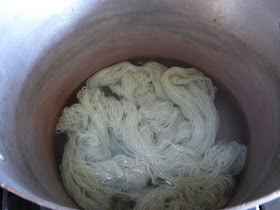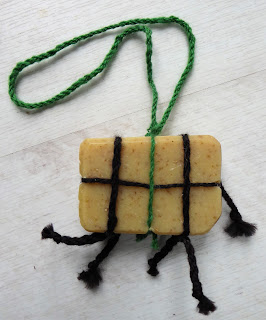"Will you look what you're doing with that wool, you're splashing water all over me."
My companion, grabbed a tea towel to wipe the screen of her beloved mobile phone while I carried on slopping wet yarn from one bowl to another.
"I think that was mordant solution, Elinor."
"Have a care, Beaut, my insurance won't cover damage by toxic waste."
"For goodness sake, there isn't enough alum left in here to pickle a gherkin. This is the third time I've reused the solution and I'm just about to pour it away." I squeezed out a skein from the rinse water and twanged the loop to straighten the yarn. Elinor dodged away from another shower of droplets.
"Well, you must have started with pounds of alum to mordant all that wool. Why aren't you using your home made jars of iron and copper solution and being more ecofriendly?"
"Hark at you, Mrs Organic, glued to the internet all day."
Elinor sat back down at a safer distance and reopened her device.
"I am doing the crossword in The Guardian Digital Edition. Which means I no longer buy a daily newspaper and I'm saving trees."
Mordanting wool with iron and copper involves heating up dilute solutions in pots, consuming more energy if less time than a cold soak in alum mordant for 24 hours. A few years ago, I tried premordanting yarn by pouring a glug from my jar of rusty nails into one pot of water and a glug from my jar of copper piping into another. Having no idea how much iron and copper had dissolved into my home made water and vinegar mixture, I guessed I'd overdone it when the iron mordanted yarn turned strongly orange and the copper mordanted yarn turned quite green. Though I wasn't wildly excited with the dull brown results of dyeing the iron and copper premordanted wool with comfrey or with meadowsweet, both plants only give muted colours whatever the mordant.
Referring back to Wild Colours by Jenny Dean, I read that as mordanting solutions, iron and copper should both be used at 2% the weight of the wool. In order to be sure how much metal I was adding, I followed the instructions and dissolved 15g of ferrous sulphate and 15g of copper sulphate with 150ml hot water in two jam jars.
Knowing 10ml of either solution would contain 1g of metal, I added 20ml to two pots of water, each containing 100g shetland wool yarn. I heated the one with iron for 15 minutes then rinsed the wool thoroughly in four changes of water. Once dried, the yarn was pale orange and the water still looked a rusty colour.
Jenny says to add white vinegar to enable wool to absorb copper, then to heat it for an hour before rinsing. Once rinsed and dried, the wool had turned pale green and the water in the pot had cleared leaving no trace of blue.
All this took place a few weeks ago, when the weather had just started to warm up and the slugs had awoken from their winter torpor and begun to feast upon my daffodils. Deadheading what was left, I picked 250g fresh, if rather wilted and chewed daffodil flowers which I soaked overnight then simmered for half an hour in water with a teaspoon of soda ash to get the pH up to 8. I added five 25g skeins of shetland yarn, one mordanted with copper and one with iron, two mordanted with alum and one with no premordant at all. Here is how they looked straight out of the dye pot, in that order starting with copper on the left.
My biggest surprise was how well the unmordanted skein (right) had dyed - previously, wool without a mordant has picked up only the palest colour from daffodils. The copper and iron mordanted wool both looked dingy shades of brown. Four of these skeins hung out to dry, cured for a few days, then had a good rinse.
Dividing the remaining alum mordanted skein into two, I modified the colour of one part by heating it in the leftover copper bath and the other part in the iron bath. I'd forgotten that the added vinegar had made the copper bath acidic, which brought the yarn's pH down from alkali and immediately robbed it of much colour.
Once dried, the alum mordanted daffodil dye (left) was not half as yellow as I've had in other years. When used as premordants the iron and copper made the yellow dye into shades of brown, while when used as modifiers on the smaller skeins of alum premordanted yarn, I had a dim orangey beige from iron and a grey green from copper (though more green than the photo shows). Not what I've had when I've modified daffodil dye before, confusing and rather discouraging results. All things considered, this attempt to explore the difference between premordanting and modifying plant dyed yarn with iron and copper turned out poorly, though there is undoubtedly a big difference in the effect both metals have when used in the two different ways.
Last week, the weather turned gloriously warm and the roadsides sprung wild with bright dandelion flowers. It only took me 20 minutes to gather over 500g, the right weight for the five to one, plant to wool ratio which I wanted in order to repeat the same experiment with another 100g shetland yarn. The sudden summer heat may be the reason that this year, I had a far brighter yellow from dandelion flowers on alum mordanted yarn (top centre). Previously, in cooler Springs, it has been much more of a dim and greenish shade. The iron mordant came out brown (left), but modifying some alum mordanted yarn with iron gave an entirely different olive green. The copper mordanted yarn turned a more golden version of yellow while the copper modified alum mordanted yarn came out lime green. Much more in line with previous modified dandelion dye experiments.
My companion and I sat on the patio drinking Pimms, her doing the crossword and me admiring my dandelion yarn and enjoying the foretaste of summer heat.
"This is the life, hey, Elinor?"
"Global warming is hardly something to celebrate, Beaut." She looked up, waved her hoof at an unseasonable wasp zooming in on the fruit slices in the jug, then frowned at me. "After all the sunshine, that grass needs cutting." As the wasp buzzed around her head, Elinor stood up and stepped backwards into a terracotta pot. "Not to mention how late you've left it to get these pots planted up." Jinking around the patio with an enraged wasp following her, she finally put down her phone and looked about for a more suitable weapon.
I sipped my Pimms.
"Bet you wish you'd bought a real newspaper now."







































